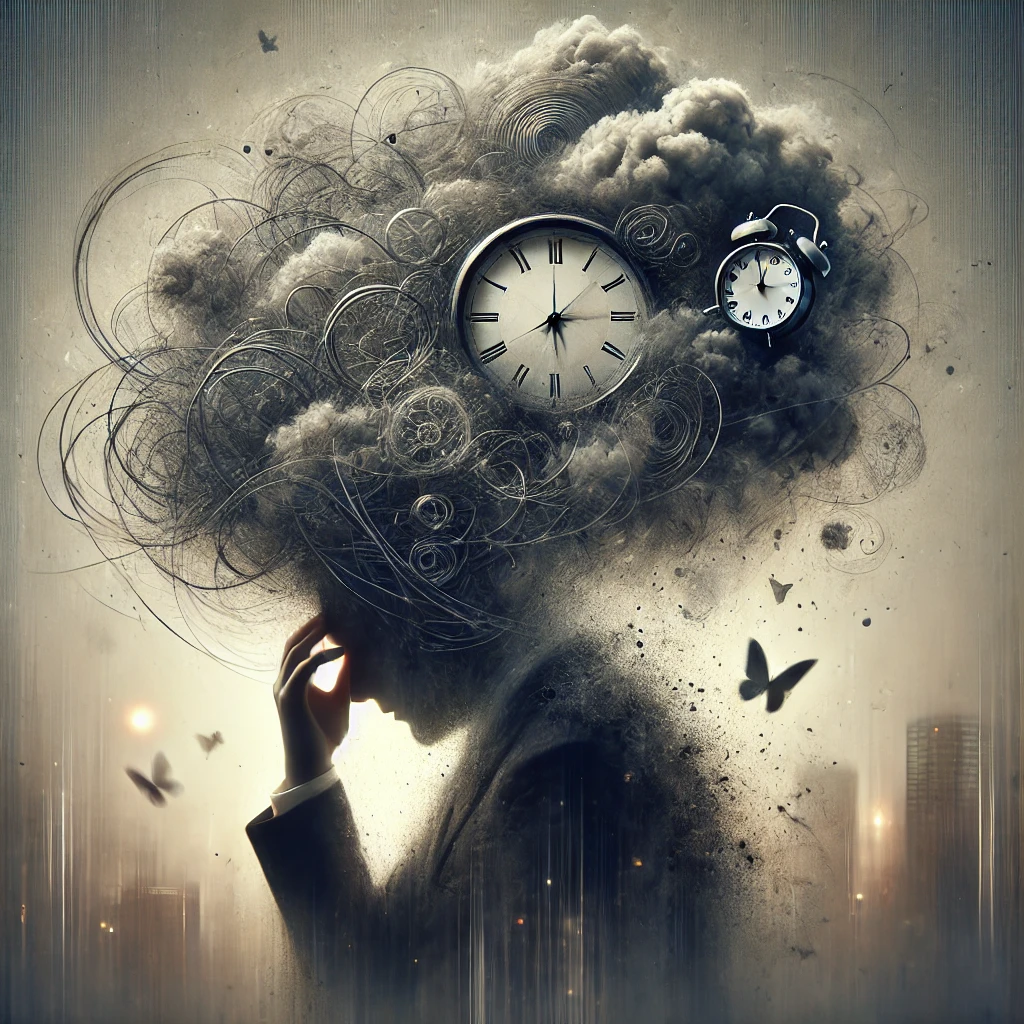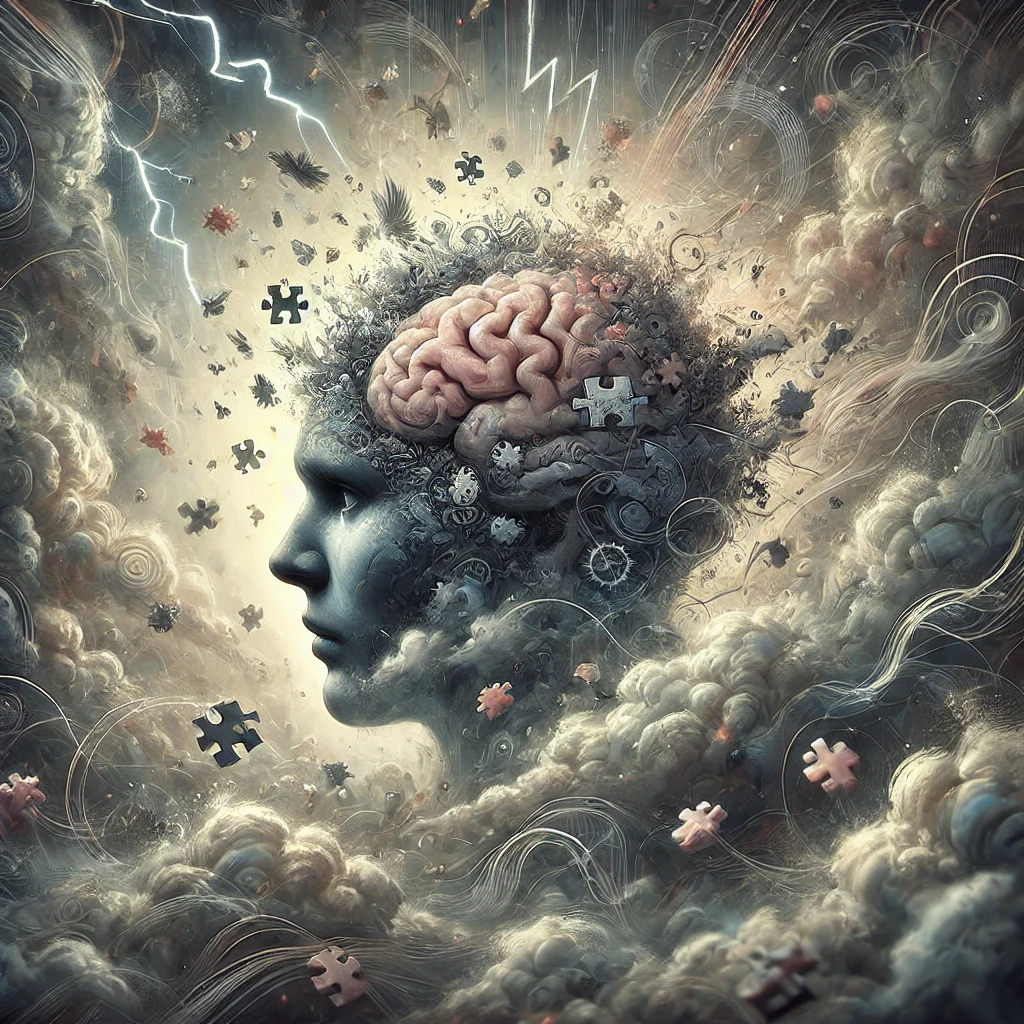Purpose of this article
The purpose of this article is to explore, explain, and bring clarity to the often unsettling visual disturbances that can accompany chronic anxiety and stress-related conditions. These visual anomalies—such as flashing lights, eye flashes, floaters, and kaleidoscope-like distortions—can be deeply distressing, often mistaken for signs of serious eye disorders or neurological illness. This article aims to offer reassurance, scientific insight, and compassionate understanding of how chronic overactivation of the sympathetic nervous system can affect our vision and perception. Our goal is to normalize this symptom and support those who are experiencing it.
It’s a deeply disorienting experience—sitting quietly, perhaps reading or relaxing, when suddenly the edges of your vision flicker with tiny bursts of light. Or maybe you catch a glimpse of something darting across your visual field—a spot, a wisp, a flash—only to realize nothing is actually there. At times, the world might even look slightly warped, as if viewed through a shifting lens or prism. These kinds of visual oddities can be alarming, especially when they appear out of the blue.
Visual disturbances are more common in anxiety than many people realize. While they may feel like signs of eye disease, migraine aura, or even neurological issues, in the context of chronic stress response or sympathetic nervous system overactivation, they can often be explained by the heightened state of physiological arousal that anxiety generates.
This doesn’t make them less scary—but it does make them more understandable. When the body is trapped in a prolonged state of threat, the nervous system sharpens and distorts sensory input. Vision becomes hypervigilant. The eyes and the brain are constantly scanning, interpreting, reacting—sometimes creating strange and unexplained visuals in the process. These experiences are not signs of “losing your mind” or permanent damage; rather, they are the body’s overstressed state spilling over into the way we see the world.
How Do Visual Anomalies from Anxiety Feel?
- Sudden bursts or streaks of light: Lightning-like flickers in the corner of your eye, often in peripheral vision and disappearing when looked at directly.
- Seeing “floaters” more frequently: Spots, threads, or web-like shapes drifting across your visual field, more noticeable against bright backgrounds.
- Flickering or shimmering vision: A shimmering effect, like light reflecting off water or glass, especially in bright settings.
- Brief flashes like camera bulbs going off: Intense, sudden flashes, often in low light or when falling asleep.
- Kaleidoscope-like distortions: Fractured, colorful, or patterned vision, reminiscent of a psychedelic or dreamlike state.
- Visual snow or static: A grainy or fuzzy overlay, particularly noticeable in low-light environments.
- Perception of movement or “phantom shapes”: Shadows, darting lights, or ghost-like movements in peripheral vision that disappear when focused on.
- Sensitivity to light and visual overstimulation: Lights may feel too harsh or chaotic environments may feel visually overwhelming.
- Feeling disconnected or like vision is “not quite right”: Described as a fog, film, or veil over the eyes.
- A sense of visual tunnel vision: A narrowed visual field during peak anxiety, reducing awareness of surroundings.
- Vision that changes depending on stress levels: Symptoms may lessen when calm and return during heightened anxiety.
Each of these experiences can be jarring, especially when they appear unexpectedly. For those living with chronic anxiety or trauma-related stress, it’s not uncommon to misinterpret these symptoms as signs of serious eye or brain issues. It’s important to get medical evaluation when in doubt, but once ruled out, understanding the link between sympathetic overdrive and sensory distortion can bring enormous relief.
Why Do These Visual Symptoms Happen?
The visual system is incredibly sensitive to the internal state of the body. Our eyes are not just passive receivers of light; they are directly wired into the brain and tightly linked with the autonomic nervous system—particularly the sympathetic branch, which governs our body’s response to stress and perceived danger.
When the sympathetic nervous system is in a state of chronic overactivation—sometimes referred to as chronic stress overstimulation, chronic overarousal, or sympathetic overdrive—many of the body’s systems begin to operate differently. The visual system is no exception. Here’s how that impacts what and how we see:
- Heightened visual sensitivity: In states of stress, your body primes itself for danger. The eyes become more alert, the pupils dilate, and peripheral vision may become more attuned to movement. This can cause visual overstimulation and lead to illusions of movement or brightness in your field of view.
- Reduced blinking and eye moisture: When in a stress state, we tend to blink less frequently. Over time, this can lead to dry eyes, irritation, and visual disturbances like light sensitivity and blurred vision.
- Increased awareness of normal internal visuals: Floaters and light phenomena are common, even in healthy eyes. But anxiety heightens awareness. What might normally go unnoticed becomes front and center in your perception—making you hyper-aware of every flicker or speck.
- Eye strain and muscle tension: Tension in the neck, shoulders, and around the eyes can alter the way your eyes focus and track, leading to sensations of double vision, eye fatigue, or distortions.
- Altered visual processing in the brain: Chronic stress may change the way visual information is processed. The brain, in its anxious state, may misinterpret signals or become “noisier,” generating phantom images, flickers, or distortions not rooted in external reality.
- Adrenaline surges and vascular changes: Spikes in stress hormones can temporarily alter blood flow to the eyes and brain. This can sometimes result in visual anomalies like flashes of light or kaleidoscope vision, especially when standing up quickly or during panic attacks.
When these factors combine—especially over days, weeks, or months of ongoing stress—it creates a perfect storm where vision is no longer consistent or comfortable. And because vision is so vital to our sense of orientation and safety, even minor visual oddities can feel overwhelming or terrifying. This is a normal response to a nervous system that has been on high alert for too long.
How Anxiety Causes Visual Distortions and Anomalies:
The Visual System (Eyes + Brain Visual Cortex) – Primary Body System Involved
- The eyes are direct extensions of the brain, relying on both nervous system function and vascular health.
- Chronic activation of the body’s stress alarm system can disrupt visual processing through:
- Erratic blood flow to the retina and optic nerve due to ongoing vessel constriction.
- Tension in eye muscles altering focus and movement subtly.
- Prolonged pupil dilation, allowing excessive light in and leading to overstimulation.
- Hyperreactive visual cortex interpreting ordinary signals with exaggerated intensity.
The Central Nervous System – Amplification Through Neural Pathways
- The visual centers in the brain become over-sensitive during ongoing stress states.
- This leads to:
- Minor floaters or flickers becoming extremely noticeable and distressing.
- Misinterpretation of visual inputs, causing flashes, flickers, and kaleidoscope-like distortions.
- Possible stress-triggered visual auras without headache (migraine variants).
The Vascular System – Contributor and Amplifier
- Chronic stress affects circulation throughout the head and eye region:
- Constriction of blood vessels may cause brief ischemic responses in the retina.
- Fluctuations in intraocular pressure from dehydration or vascular shifts can make floaters more visible.
Complex Interplay Symptom: A Fusion of Systems
- This symptom is not isolated to one system—it involves:
- The visual system (eye structures + brain processing centers).
- The nervous system (sensory processing and hyperresponsiveness).
- The vascular system (circulation and nutrient delivery).
- Neck and scalp tension from stress may reduce blood and nerve flow to visual pathways, contributing indirectly to visual anomalies.
Medical Advisory: What These Visual Symptoms Are Often Mistaken For
It is important to consult a medical professional to rule out physical conditions that may cause similar symptoms. These may include:
- Retinal detachment or tears – flashing lights, sudden floaters, or shadowy curtains.
- Ocular migraines – kaleidoscopic or shimmering visuals with or without headache.
- Optic neuritis – pain and vision changes due to optic nerve inflammation.
- Multiple sclerosis – early visual disturbances.
- Vitreous detachment – common with aging but can resemble anxiety-induced floaters.
- Temporal arteritis – inflammation affecting blood vessels near the eyes.
- Seizure disorders (especially occipital lobe) – visual auras and flickering patterns.
- Medication side effects – visual changes linked to certain drugs.
- Dehydration or electrolyte imbalance.
- Diabetes-related eye changes (retinopathy).
- Thyroid-related eye disorders.
If all diagnostic options have been exhausted and
What Can Help?
The path to relief starts with understanding that these visual symptoms are not dangerous, even though they feel distressing. Once serious medical issues have been ruled out by an eye doctor or neurologist, the focus can shift toward soothing the overworked nervous system and restoring a sense of safety in the body and brain.
Here are some supportive practices that can aid in recovery:
- Gentle nervous system regulation: Practices that calm the sympathetic nervous system are essential. This may include slow, diaphragmatic breathing, progressive muscle relaxation, or grounding exercises that help re-anchor you in the present moment.
- Intentional visual breaks: Reducing visual overstimulation by taking regular screen breaks, softening indoor lighting, and resting your eyes periodically throughout the day can give the visual system time to reset.
- Reassurance through education: Simply learning that these symptoms are common in anxiety can provide huge relief. Many people find that knowing the “why” behind their symptoms helps them detach from the fear they generate.
- Therapeutic support: Working with a trauma-informed therapist, especially one who understands nervous system dysregulation, can help address the root causes of chronic anxiety and stress arousal.
- Reduce stimulants: Limiting caffeine, alcohol, and other nervous system stimulants may help reduce the intensity and frequency of visual symptoms over time.
- Re-engage with safety cues: Visual symptoms tend to quiet when the brain begins to feel safe again. Activities like being in nature, connecting with trusted people, listening to calming music, or practicing restorative yoga can all signal to the brain that it’s okay to downregulate.
- Patience and persistence: Nervous system recovery takes time. Symptoms often come and go in waves. Progress may feel slow, but with continued support, many people find these visual disturbances gradually lessen and, in many cases, resolve completely.
Remember, just because a symptom feels severe doesn’t mean it’s dangerous. These visual disturbances are your body’s way of saying, “I’m overwhelmed.” By learning to listen with curiosity and compassion—not fear—you begin to create the conditions for healing.


